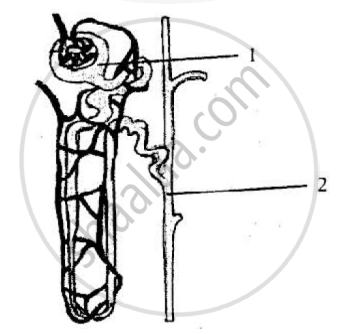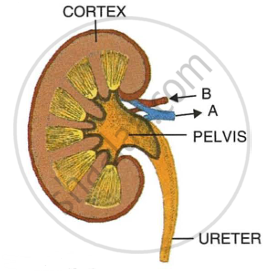Advertisements
Advertisements
Question
The diagram given below is that of a structure present in a human kidney.
Study the same and answer the questions that follow:

1) Name the structure represented in the diagram
2) What is the liquid entering part ‘1’ called?
Name two substances present in this liquid that are reabsorbed in the tubule.
3) What is the fluid that comes to part ‘2’ called?
Name the main nitrogenous waste in it.
4) Mention the three main steps involved in the formation of the fluid mentioned in (iii) above
5) Name the substance which may be present in the fluid in part ‘2’ if a person suffers from Diabetes mellitus.
Solution
1) Nephron
2)
- Glomerular filterate
- Glucose and Amino acids
3)
- Urine
- Urea
4) The 3 steps are
- Ultrafiltration
- Selective Reabsorption
- Tubular secretion
5) Glucose
APPEARS IN
RELATED QUESTIONS
The nephrons discharge their urine at ______.
Fill in the blank.
.................. produces bile pigments from the heamoglobin of broken RBCs.
Differentiate between the following pairs of term :
Renal cortex and renal medulla
Given below is a simplified diagram of the human kidney cut open longitudinally. Answer the questions that follow.
 |
- Define excretion.
- Why does the cortex of the kidney show a dotted appearance?
- Why does the medulla of the kidney show a striped appearance?
- Write two differences in the composition of the blood flowing through the blood vessels 'A' and 'B'.
Name the following:
Functional unit of kidney.
When uric acid is produced in excess, it gets deposited in joints, resulting in ____________.
The process of diffusion of solvent particles from the region of less solute concentration to a region of high solute concentration through a semi-permeable membrane is known as ____________.
In a person the tubule part of the nephron is not functioning at all. What will its effect be on urine formation?
If a plant is releasing carbon dioxide and taking in oxygen during the day, does it mean that there is no photosynthesis occurring? Justify your answer.
